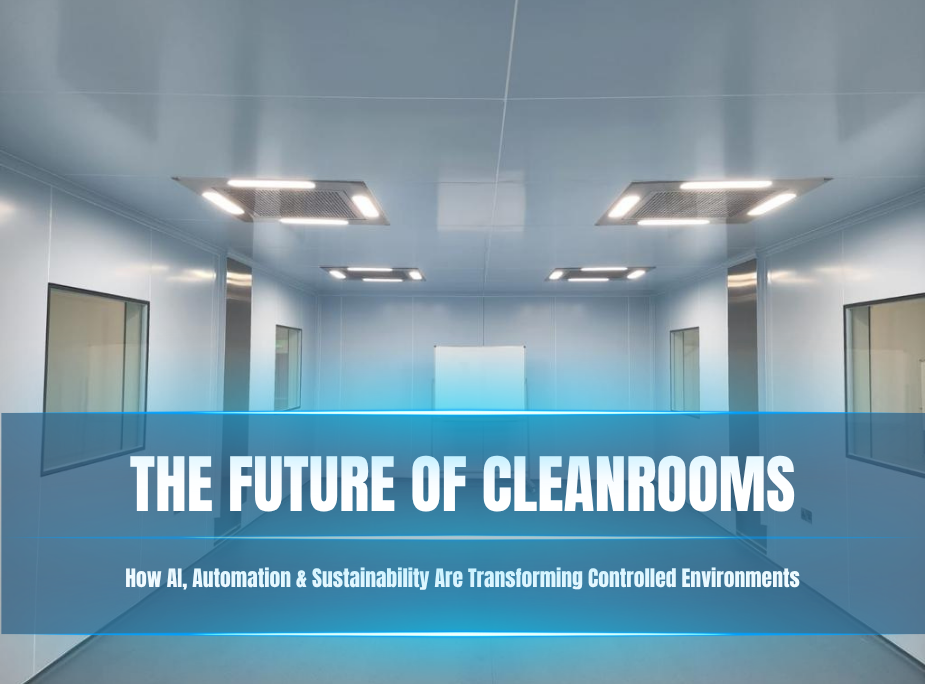The Future of Cleanrooms: How AI, Automation, & Sustainability Are Transforming Controlled Environments

Have you ever stepped into a room so meticulously controlled that a single microscopic particle could derail an entire operation? Do it and you’ll realize you’ve entered the world of cleanrooms. Here, precision, sterility, and cutting-edge technology converge to protect processes critical to industries from pharmaceuticals to semiconductors. But cleanrooms are no longer just about containment, they are evolving. With the rise of AI, automation in cleanrooms, and sustainable design, the future promises intelligent, adaptive environments that do more than maintain cleanliness, they optimize, predict, and protect like never before.
In this post, we’ll explore the transformative future of cleanrooms, diving into how AI, automation, and sustainability are redefining what it means to operate in controlled environments.
The Evolution of Cleanroom Technology
Cleanroom technology has evolved dramatically since its inception. Traditionally, cleanrooms were designed to minimize particle contamination using rigid layouts, HEPA filtration, and strict procedural controls. Pharmaceutical cleanrooms, for example, are governed by stringent regulations like ISO 14644 and EU GMP, ensuring that medicines are manufactured under conditions that prevent contamination and maintain product safety. Similarly, semiconductor cleanrooms demand even higher precision, with airborne particle counts measured in mere single digits per cubic meter, because even the tiniest impurity can ruin microchips worth millions.
However, the modern era calls for more than just particle control. Today’s cleanrooms are evolving to integrate digital intelligence, real-time monitoring, and energy-efficient designs, making them smarter, faster, and more sustainable.
AI: The Brain Behind Smart Cleanrooms
Artificial intelligence is rapidly becoming the backbone of next-generation cleanroom technology. In traditional setups, human operators must constantly monitor environmental parameters such as temperature, humidity, air pressure, and particulate levels. Even with rigorous SOPs, errors and inefficiencies can occur. AI-powered cleanrooms mitigate these challenges by enabling predictive analytics, anomaly detection, and autonomous decision-making.
For instance, in pharmaceutical cleanrooms, AI algorithms can predict contamination risks by analyzing patterns in airflow and personnel movement. This proactive approach not only prevents batch contamination but also optimizes cleaning schedules, reducing downtime and operational costs. Similarly, semiconductor cleanrooms leverage AI to monitor ultrafine particle accumulation in real time, automatically adjusting filtration systems to maintain pristine conditions. The result is a self-optimizing environment where efficiency and safety coexist seamlessly.
Automation: Precision at Scale
If AI serves as the brain, automation in cleanrooms acts as the muscle, executing precise tasks with minimal human intervention. Automation technologies range from robotic arms and conveyor systems to fully automated material handling and cleaning protocols.
In pharmaceutical cleanrooms, automation is revolutionizing processes like sterile filling, packaging, and sampling. Robotic systems ensure that products are never exposed to potential contaminants from human contact, while automated monitoring ensures regulatory compliance is maintained without manual oversight.
Semiconductor cleanrooms also benefit immensely. Automated wafer handling, inspection, and assembly reduce the risk of particulate contamination, accelerate production cycles, and enhance yield. Combining AI with automation in cleanrooms enables adaptive systems that respond instantly to environmental changes, marking a significant leap from traditional, labor-intensive operations.
Sustainability: The Green Revolution in Cleanrooms
While precision and efficiency remain crucial, sustainability is emerging as a pivotal factor shaping the future of cleanrooms. Traditionally, cleanrooms consume vast amounts of energy to maintain HEPA filtration, HVAC systems, and stringent environmental conditions. Modern innovations aim to reduce this footprint without compromising performance.
Smart cleanroom technology now integrates energy-efficient air handling, variable-speed fans, and predictive environmental control powered by AI. Pharmaceutical cleanrooms, for example, can use real-time data to adjust airflow and temperature only when necessary, significantly reducing electricity usage. Similarly, semiconductor cleanrooms are adopting advanced filtration technologies and energy-recovery systems to minimize operational waste.
Sustainable design doesn’t stop at energy efficiency. Materials selection, modular cleanroom construction, and water recycling systems are becoming standard. These innovations not only benefit the environment but also reduce long-term operational costs, creating a win-win scenario for companies and the planet.
Convergence of AI, Automation, & Sustainability
The most exciting frontier in cleanroom technology lies at the intersection of AI, automation in cleanrooms, and sustainability. Imagine a pharmaceutical cleanroom where AI predicts contamination hotspots, automated systems adjust airflow in real time, and energy use is optimized for minimal environmental impact, all functioning harmoniously. This is no longer a futuristic concept but a reality in leading-edge facilities worldwide.
For semiconductor cleanrooms, the convergence is equally transformative. AI-driven predictive maintenance prevents equipment failures, automated robots handle sensitive wafers without human contact, and energy-efficient systems reduce carbon emissions. The result is an environment where productivity, precision, and sustainability coexist without compromise.
Challenges & Considerations
While the potential of AI, automation in cleanrooms, and sustainable cleanroom technology is enormous, the transition is not without challenges. High upfront costs, integration complexity, and regulatory compliance are significant hurdles. Additionally, cybersecurity becomes crucial as cleanrooms become more digitally connected. Organizations must ensure that AI and automation systems are robust, secure, and validated according to industry standards.
Furthermore, training human operators to work alongside intelligent systems is essential. Rather than replacing staff, the goal is to augment human capabilities, allowing personnel to focus on decision-making, quality oversight, and innovation.
The Future Landscape
The trajectory of cleanroom technology suggests a future defined by intelligent, autonomous, and environmentally responsible operations. Industries are poised to benefit from:
- Predictive AI Monitoring: Anticipating contamination risks before they occur.
- Autonomous Robotics: Executing critical tasks with unmatched precision.
- Energy-Efficient Designs: Minimizing environmental impact without sacrificing performance.
- Modular and Adaptive Layouts: Enabling scalable and flexible operations.
Plus, in this evolving landscape, both pharmaceutical cleanrooms and semiconductor cleanrooms are becoming more than controlled spaces, they are becoming smart ecosystems capable of learning, adapting, and optimizing themselves.
The Rise of Intelligent Cleanrooms
The future of cleanrooms is no longer confined to controlling particles, because now it is more about controlling intelligence, efficiency, and sustainability. As AI, automation in cleanrooms, and green technologies converge, cleanrooms are transforming from rigid, labor-intensive spaces into dynamic, self-optimizing environments.
For businesses and researchers, embracing these innovations is a competitive advantage. The cleanrooms of tomorrow will not only protect products and processes but also protect our planet, streamline operations, and elevate the standards of precision to levels previously thought impossible.
So interestingly, in this era where every particle matters, the future is clear, intelligent, automated, and sustainable cleanrooms are here to lead the market and redefine the boundaries of controlled environments.
Don’t let outdated systems slow you down, upgrade to automated, sustainable cleanrooms today.




